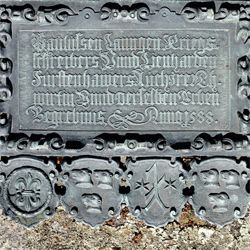Lienhard (Leonhard)
Fürstenhauer
,
died Nürnberg, 27. Feb 1588
Son of Hans, carpenter and box painter. ∞ I) 1.2.1556 Elisabeth Storr († October 1562); II) 1.2.1563 Felicitas, daughter of Leonhard Bischof, Gürtler, granddaughter of the painter Michael Wolgemut; III) April 19, 1575 Susanna Bernbeck (died Sept. 17, 1556 – died Jan. 22, 1596). In 1555 he took over his father's stall under the furrier's house next to the Frauenkirche. In 1570 he got the council to allow him to employ journeymen and apprentices to make the boxes. In August 1576 he was forbidden to paint the boxes and to employ painters to do this; This ban was lifted in September 1577 after Simon (Sigmund) Steinhauser and other traders and buyers of his goods lobbied Fürstenhauer. He visited the Frankfurt trade fairs to sell his goods there. 1586-88 he was mentioned. In 1579 he paid 44 florins in taxes, making him one of the 100 richest citizens in the city. On June 9, 1584, he received a six-year monopoly in Berchtesgaden for the sole purchase and distribution of certain sets and boxes. Samples were given to the craftsmen to make them; the others were not allowed to sell such products inside or outside the country. In 1562 Fürstenhauer lived in Neue Gasse. In 1566 he bought the house at Weißgerbergasse 14 for 400 florins, which was charged with 20 florins' own interest (comparable to a mortgage). In 1586 he purchased the property at Breite Gasse 38 for 220 florins, which his wife (or widow) Susanna sold again in 1588 for 336 florins. In the end he lived in Judengasse. His widow Susanna Bernbeck (died September 17, 1556 – died January 22, 1596) married Hans Nürnberger, a merchant, who took over the house on Weißgerbergasse. His daughter Susanna married Tobias Holl, a merchant from Augsburg, in 1588. Lit.: AKL; Thieme Becker; Roth, 1802; Baader, in: Zahns Jb. I, 1868, p. 228f.; GNM M, 1890; Hampe, Rev.; Burger, 1972 No. 7451; KDM Nuremberg, 1977; Bauernfeind, 2000; Tacke, 2001, family tree 33; Grieb, Artist Lexicon 2007; Zahn, DI-N No. 1844; Kohn, NHb Lorenz and Sebald.
Style: Renaissance
Period: 16th c.
